#1.85:1
Explore tagged Tumblr posts
Text














**Shots of the Episode**
The Bear (2022)
Season 3, Episode 9: “Apologies” (2024) Director: Christopher Storer Cinematographer: Andrew Wehde
#shots of the episode#the bear s3#the bear#the bear season 3#fx#the bear apologies#apologies#christopher storer#andrew wehde#cinematography#hulu#jeremy allen white#ayo edebiri#ebon moss bachrach#lionel boyce#carmy berzatto#chicago#sydney adamu#richie jerimovich#gillian jacobs#cooking#tv stills#1.85:1#2024#2024 tv#fx on hulu#screencaps#tv screencaps#tv
69 notes
·
View notes
Text
Dune 1 looked good visually but it did look less colorful than I was expecting from the director of Blade Runner 2049. Dune 2 looks pretty much exactly like what I was expecting and wanted Dune 1 to look like
#dune 1 would also look better if they fuckin released it with the imax aspect ratio on home video#or at the very least 1.85 like they did for Nope and Christopher Nolan movies
0 notes
Text
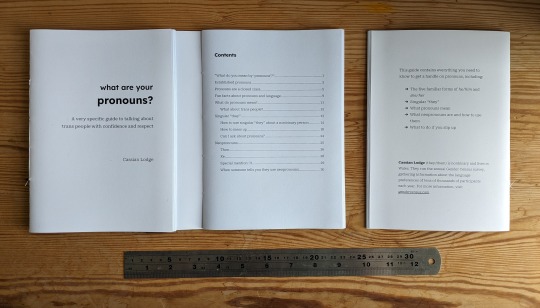
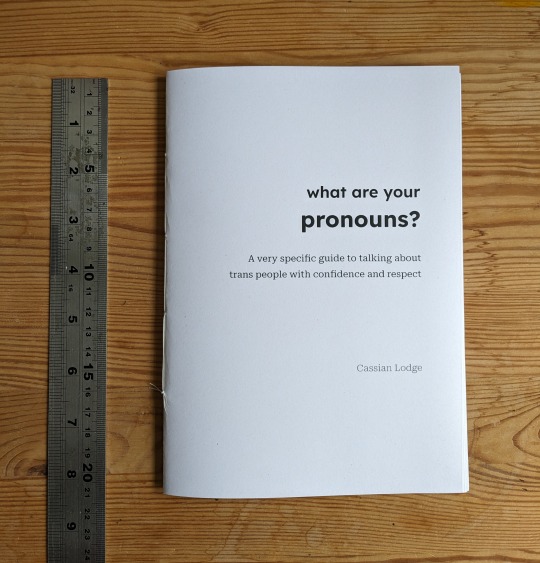
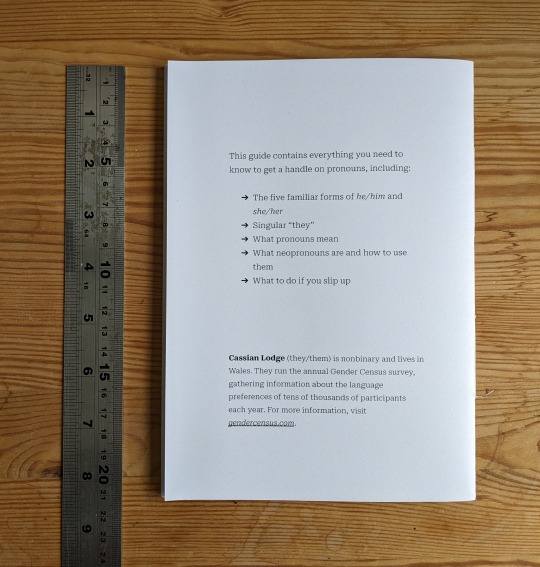
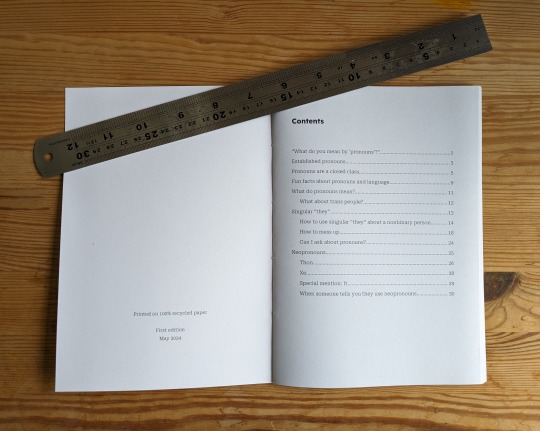
New zine for sale!
"What are your pronouns?"
A very specific guide to talking about trans people with confidence and respect
It's aiming to be a beginner-to-advanced guide for allies, with an informative and nerdy tone. It explains:
Third-person, personal, singular pronouns (with established examples)
Why learning new pronouns is harder than learning new names
Why singular they always has plural verbs (always "you are" and not "you is", even when talking about one person)
How to use they/them for nonbinary people (including themselves vs. themself)
How to mess up gracefully (with a focus on making it more comfortable for the trans person)
What neopronouns are
This zine is 36 sides of A5, with 120 gsm 100% recycled paper pages and 100% recycled card cover, handstitch-bound.
It's informed by my 12 years or so of running the Gender Census and gathering data from tens of thousands of nonbinary and gender-divergent people, so this might be the closest I've gotten to official Gender Census merch!
How to buy
Here are some purchase links for one copy:
UK 1st class, £6.35 - £4 for one copy, plus UK first class postage £2.35 (1-2 days)
UK 2nd class, £5.85 - £4 for one copy, plus UK first class postage £1.85 (2-4 days)
Outside UK, £7.20 - £4 for one copy, plus postage to anywhere outside of the UK £3.20 (5-7 working days)
Update 2024-06-20: They’re now available through our new online shop!
If you'd like to buy more than one copy then please do email me for a quote. It's £4 GBP per copy, plus P&P from the UK to wherever you are. I can take payment by bank transfer or PayPal. You can message me here on Tumblr or, more reliably, email me: [email protected] (And if you are curious to see what else I've got in stock crafts-wise, you can check out my "things for sale" page here.)
And a quick reminder that the annual survey is currently open until 13th June 2024 - 38,000 participants and counting!
Thank you for your attention, folks. Now back to the usual statistical enthusiasm. ✨📊
369 notes
·
View notes
Text
I'm translating the entire TGCF audio drama!!

🌸 Hello everyone! ~ ♡
I'm pretty new to the community but completely fell into the TGCF hole. This is gonna be a pretty big ongoing project for me: 1) To share the wonderful work and story that is TGCF 2) To improve my Chinese along the way, so my TLs will have Chinese subs, as well as English 3) Contribute a lil something to the community 🦋
I've previously asked on Reddit to see if this would even be something people wanted, as it's been a while since the first EP uploaded, but I still can't find any comprehensive catalogue that has all the episodes available. And now that the production team has finished S2, I will have plenty of time to work on the EPs before S3 comes :>
Links !
So far I've only done the theme song, season 1 EP 1 and Mini Theatre 1. You don't need POP for now and I'll see how that goes. But please buy the drama if you enjoy it (´。• ◡ •。`) ♡
Bestow Me (Ci Wo) S1 theme song S1E1 Mini Theatre 1
I've worked quite hard on this so plsplspls DO NOT steal my work !!!! It's a solo ship for now so I'd appreciate any feedback that I can get ✨ When in doubt, I referenced the translation from the official TGCF novels from Seven Seas.
If S2 is in more popular demand than S1 I wouldn't mind starting there and working backwards either!
How to view !
Download the video for the best viewing experience 🎧 FYI I've used the 1.85:1 ratio for now
Mega app/Mega website on a desktop
Download VLC player (desktop or Android)
Infuse app (iOS)
TGCF Audio Drama
☆S1 ☆S2
Purchasing TGCF AD (@withhualian on X)
Support MissEvan 猫耳FM
The audio drama team worked really hard on this, they deserve all the support they can get, so we can also have S3! Please buy the AD on MissEvan if you can, it’s really cheap. I've linked below some resources that are helpful and easy to get started ☆
Guide to MissEvan (@dimsumplingg and co. on X)
Video Guide to MissEvan (Wei Su Jen on YT)
Completing daily tasks on MaoEr app (WBOY)
art from TGCF AD's official Weibo
#tgcf#mxtx#tgcf audio drama#tgcf ad#hualian#fansubs#fan translation#heaven official's blessing#tian guan ci fu#i can't believe i'm getting back on tumblr cuz of tgcf#i am so tired from tl-ing but also so passionate ahAHAHA
183 notes
·
View notes
Text
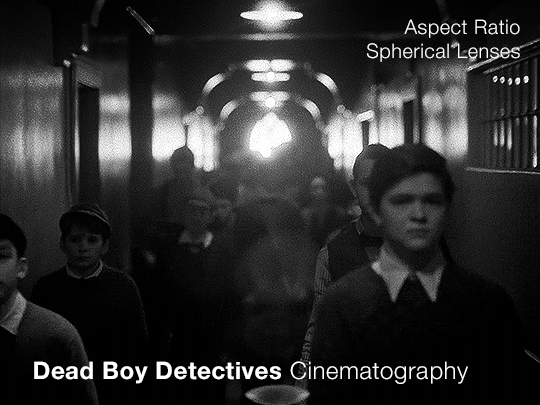
Part 2 — this time with a focus on the flashbacks
(Check out the first post for some background info that will be useful)
When we’re looking at the cinematography of any piece, once we’ve established what the norm is (which is the use of anamorphic lenses, as per the last post) we can then look to see where it diverges. As far as I can tell, the only part of Dead Boy Detectives that doesn’t use an anamorphic lens is Edwin’s flashback scene.
Now this is particularly interesting since not only is it filmed with a spherical lens, but it also is the only scene with a different aspect ratio, and the only scene in black and white. Everything about this scene is glaringly different. The easy and obvious reason is that it sets this scene apart as something important to pay attention to, as well as emphasizing the difference in the time period. But I want to highlight how exactly it does this since it is quite clever.
It also raises the question: Why not film Charles’ flashback scenes differently?
Like last time, let’s start with a review of history and technical information.
What is an aspect ratio?
This is just the ratio of the width to height of the frame. 1:1 is a square, whereas 2:1 is a rectangle twice as wide as it is high. In film, aspect ratios are usually listed as a ratio of x:1, so you get common formats like 1.85:1 and 2.39:1 (the second being a super-widescreen format, i.e. a long rectangle). Other common ratios are listed with different numbers, like 4:3 and 16:9. Any time I write an aspect ratio with other numbers, I’ll also list it at least once with the x:1 format so you can compare things easily.
What are some common aspect ratios and what have the standards been across the past 100+ years of film and television history?
Brief history of aspect ratios in Film
The original silent films were mostly filmed in 4:3 (1.33:1). This aspect ratio persisted until the late 20s/early 30s when the Academy Ratio, 1.375:1, was introduced and somewhat standardized (at least in the USA) until the 50s. Then, widescreen became pretty popular and was used to draw audiences to the theaters. At this point, we get tons of variation in aspect ratios in films. But, for American theaters, common projections are 1.85:1 (which became super common) and 2.40:1 or 2.39:1, whereas in some European theaters, 1.66:1 is a more common ratio.
Some other common ratios deal particularly with 70mm film:
Standard 70mm film is usually 2.2:1. However, using anamorphic lenses will create a higher aspect ratio, and unless using a specific format common in the 50s and 60s (Todd-AO), this wasn’t often the aspect ratio that viewers would see. (The Sound of Music was shot with Todd-AO in 2.2:1, but until recently, most people only saw the general release in 35mm, which had a different aspect ratio)
IMAX, which is 1.43:1 (if IMAX is shot on film and not digital, it uses 70mm film)
Brief history of aspect ratios in Television
Pretty much all televisions until around the 1990s-2000s used 4:3, and broadcasters would show content in that aspect ratio. If a movie was broadcast over TV, sometimes there would be letterboxing (black bars), but pan-and-scan was common, where they would crop the movie to the 4:3 ratio, and pan around to wherever the action was happening. Starting in the 90s, widescreen televisions started to gain traction, and the 16:9 (1.77:1) format prevailed, and TV broadcasting had some more wiggle room for aspect ratio.
**Side note: Computers are often at this ratio, so if you watch older TV shows on your laptop, you’ll probably see pillarboxing (black columns on the sides), whereas newer movies are often shot with higher aspect ratios so they have letterboxing (black bars on the top and bottom)**
A note on widescreen
Movies are usually considered widescreen if they’re any higher than 4:3 (or 1.33:1). However, because of the aspect ratio of modern TVs and computers, and the even higher aspect ratios of most smartphones in landscape mode, a lot of people (especially younger generations) won’t consider things “widescreen” until they’ve got a much higher aspect ratio.
Streaming and Aspect Ratios
A weird effect of streaming services, and in particular Netflix, was the rise of a new standard in aspect ratios, 2:1. It’s used in shows like Stranger Things. It’s widescreen enough that it feels cinematic but it displays well on lots of devices. There’s minimal letterboxing (or none) on your phone, and more letterboxing on your computer and TV, but not enough to seem like you’re watching a movie instead of a show.
Netflix (and Amazon) really like this aspect ratio. In 2017, one of the production requirement documents from Netflix stated that any aspect ratio greater than 2:1 had to be subject to further approval (though now they state “Aspect ratio choices should be discussed with Netflix for approval”). It’s become increasingly common, and these companies have a pretty set standard for 1.9:1 and 2:1. If we see those ratios on a streaming show it isn’t always a creative choice, similar to the way older TV shows were required to be in 4:3.
A brief reminder about lens types with some extra bits about the timeline.
That 2.39:1 aspect ratio that movies use? That’s the standard for anamorphic lenses (discussed in Part 1). Anamorphic technology was developed around 1915 (for military reasons), but wasn’t used for films until 1927, and didn’t become commonly used until the 50s.
So, with that, let’s look at Dead Boy Detectives.
Aspect Ratio
The whole show is shot with anamorphic lenses, but instead of a 2.39:1 ratio, they use a 2.2:1 ratio. This is a really interesting choice since it is an uncommon ratio. It’s more widescreen than Netflix shows (they started shooting before being acquired by Netflix though so we can ignore any impact Netflix may have had on this decision) but not quite the widescreen that anamorphic lenses typically use.
Movies and shows can use almost any aspect ratio today, but it is still common to stick to the standards. When they choose something else, it’s not because of technical limitations, but because of a creative choice.
The one caveat I have is that Doom Patrol used 2.2:1, so it’s possible that HBO and DC originally just chose this for continuity between the two, before the show was shifted over to Netflix and the Sandman universe. But for this post, I’m going to assume that they were sort of starting from scratch when choosing the look.
If we consider what a 2.2:1 ratio has been used for, and what viewers have been “trained” to associate it with, we end up with Todd-AO 70mm prints and a few others from the 50s and 60s. It’s the kind of aspect ratio you don’t see often unless you’re lucky enough to live near a theater with a 70mm film projector. There are a few notable movies shot in this aspect ratio: Lawrence of Arabia and 2001: A Space Odyssey. Some more recent movies that used 2.2:1 include Dunkirk, Tomorrowland, Nope, and the non-IMAX parts of Oppenheimer. It’s also occasionally used in recent TV, but not a ton, and not with many popular shows.
This is an aspect ratio used by large-format, high-budget movies. As mentioned in the previous post, anamorphic lenses are associated with a romanticized notion of “cinema” and this aspect ratio only serves to further that, associating Dead Boy Detectives with the limited pool of content made in this aspect ratio. It may be a TV show, but it’s being shot like a movie.
Another really interesting point that follows up on the previous post is the idea of using cinematography to enhance the sense of the supernatural and separate the characters from the normalcy of the real world. The aspect ratio is a bit unnatural too, which serves to complement and augment this.
Let’s briefly look at what the show would look like in different aspect ratios. As a baseline, this is the 2.2:1 aspect ratio that the show is in:
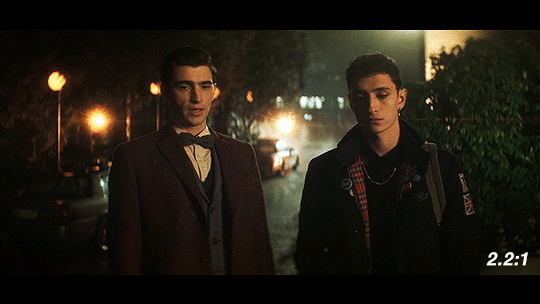
If they had gone for a 2.39:1, a very typical aspect ratio for the kind of lenses they’re using, it would look like this:
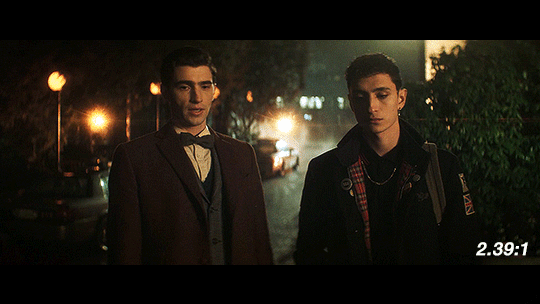
When we see things shot with anamorphic lenses, we’re used to seeing it in a frame like this one. Especially in shots like this with the dramatic lens flares, this is going to look and feel familiar to people who watch a lot of movies. It has more of that Star Trek (2009) look, and feels kind of glossy and polished.
Next up, we have 2:1, the aspect ratio popularized by Netflix. It’s a reasonable possibility that if this show had been produced by Netflix from the very beginning, this is what it would look like.

Over the past few years, this has become the “streaming platform” aspect ratio. With the extra vertical height, it’s got some extra space to breathe. We would get less of the background and more of the characters, especially since Dead Boy Detectives favors centered shots of single characters over group shots like this one.
Finally, I’ve got the scene in 1.85:1, a ubiquitous film aspect ratio, yet one that is not used often on TV.
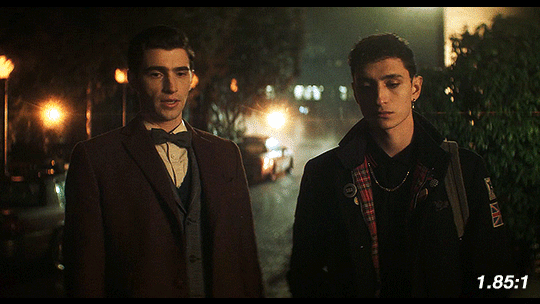
This is considered to be standard widescreen and it’s a great aspect ratio. Given how many creative decisions in this show were made to emphasize the supernatural, this could have been another good option as an aspect ratio, since we’re not used to seeing TV shows like this. However, they’re using anamorphic lenses so this would have required a lot of cropping. Because of how the anamorphic lenses work, this would also necessitate a lot of additional attention during the shoot. If they had gone with 1.85:1, we likely would have gotten a show shot on sphericals instead.
So what about Edwin’s flashback?
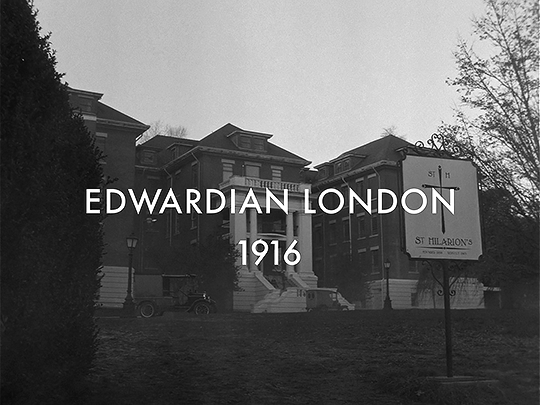
This section is shot in 4:3 (1.33:1). It’s the only part shot in a different aspect ratio. Sure, changing the aspect ratio forces us to acknowledge the difference in time period, but why exactly does it work so well?
Remember the history part? 4:3 was used for most of the early silent films. If we are to consider the “historical accuracy” of shooting the different time periods in this show, anamorphic lenses and 2.2:1 make sense for the present-day parts and Charles’ flashback.
But in 1916, widescreen cinema wasn’t a thing. If Edwin had ever been to see a movie while alive, it would have been in 4:3. The first time he would have ever gotten to see something in widescreen (if we assume he watches any movies at all) would be after he escaped Hell.
Using this aspect ratio is not just a vague decision that a lower aspect ratio and black & white looks older. It is, like many other aspects of the show, historically informed. They could have used the academy ratio here, but they didn’t. They used 4:3.
Not only does the aspect ratio switch for this scene, but also the height of the image changes.
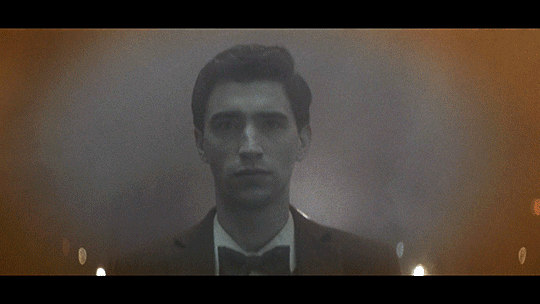
This transition also sort of mimics the breathing effect of anamorphic lenses:
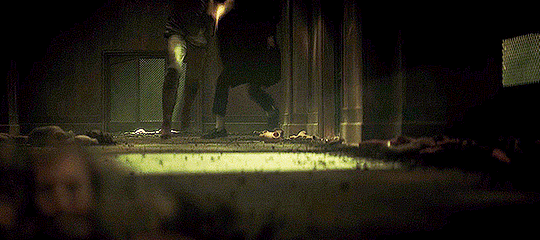
Something you may not know about how Netflix usually works is that regardless of the aspect ratio of the picture, the video file you see is part of a larger container, which is usually 16:9 (1.77:1). The black bars on top and bottom are part of the file, as shown in this screenshot of how it looks when you load up some screencaps in photoshop.
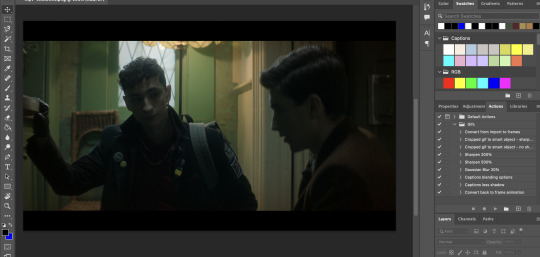
If you make gifs, edits, or are otherwise just used to having video files you are probably familiar with this. The Dead Boy Detectives files have letterboxing that is cropped out whenever people make fan content with it, whereas if you have a file for an independent movie, it usually does not have those black bars. Those black bars being part of the file make this transition possible.
We don’t usually realize that the container extends beyond the picture. For all we know, that’s the edge of the frame. But then it changes and forces us to reconsider what we previously thought to be true. Breaking out of what we think to be the image height is jarring, especially considering that this is the only time it happens (other than the brief flashbacks to the same footage later in the show).
Here’s a mockup of what it would look like if they kept the same image height, and just moved from 2.2:1 to 4:3 without expanding vertically. I find that it doesn’t have quite the same effect.
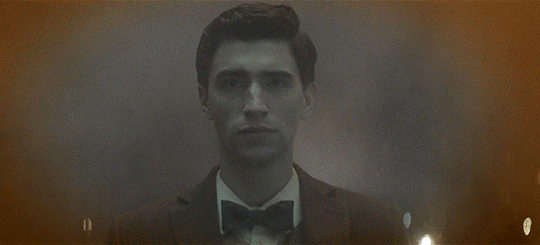
This would look so cool if it was being shown at a movie theater on a huge widescreen, but we’re not watching this show in theaters. We’re watching it on screens where this would make it look small; what they do instead retains the feel of watching something big and cinematic.
So back to the actual transition:

In breaking out of the perceived container, it’s as if it were breaking the fourth wall, an acknowledgment of the video’s format and its true container. This story is addressed to the audience in a way that the rest of the show is not, and it uses the aspect ratio to let us know that.
Spherical Lens
(I would highly recommend you read pt 1 if you haven’t already)
Edwin’s flashback is not only the sole scene with its own aspect ratio, it’s also the only scene shot with a spherical lens. Like the aspect ratio, this is a historically informed choice. Anamorphic lenses technically existed during the last year or two of Edwin’s life, but movies were not being shot on them.
How do we know that a spherical lens is being used, and how does this affect the show?
One of the quickest ways to identify the lens is to look at the shapes of the bokeh. There’s not much bokeh in the flashback, so I apologize for the intensity of my first example. But here, look behind Edwin’s head, where the lights from above reflect on the wet basement floor. They’re all circles, instead of the ovals that we get with the anamorphics.

The lens flares are also really different. Remember that the anamorphic lens flares are horizontal lines. Spherical lenses don’t do that, but they can produce lots of different kinds of lens flares. In this shot, the flashlight pointed at the lens lets off lines in lots of directions, kind of like sun rays.
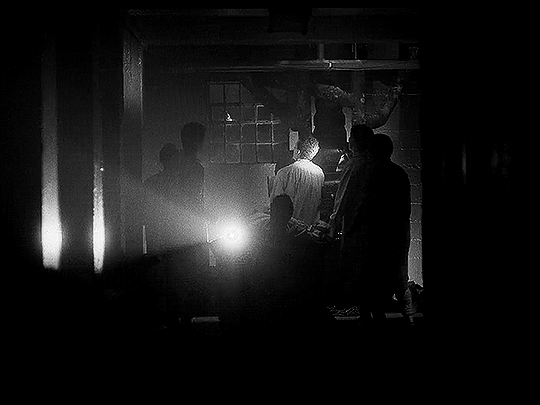
This shot has another cool flare, in much more detail this time:
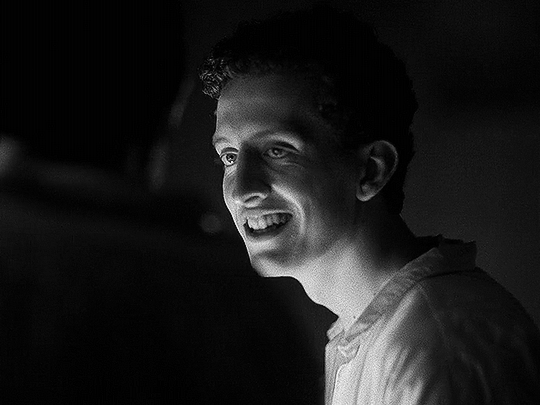
The next shot shows us more of the circular bokeh and another kind of lens flare.
For the bokeh, look at the lights on the ceiling as well as the corners of the out-of-focus architectural details (the semi-arches).
The lens flare here is the bouncing, blurry circle near the middle, as well as the brighter shape near the center bottom.
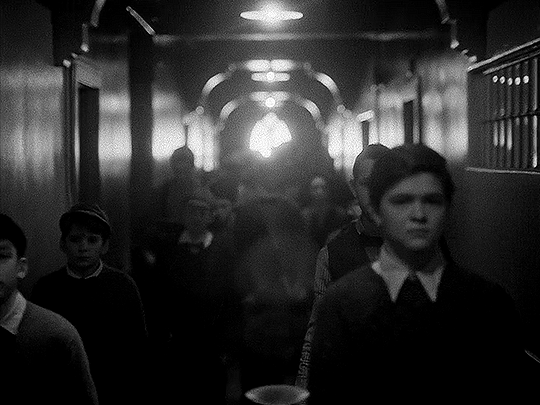
We can then look at the things that are not different, but absent when using the spherical lens: barrel distortion and focus falloff.
In this example, look at the windows in the background, as well as Edwin’s chair. An anamorphic lens would distort the vertical lines, bending them into a gentle fisheye. It would also make that chair and the lines of the window frames a bit blurry, as they’re close to the edges of the frame. Instead, the lines are straight and clear throughout the whole shot.

In this next example, not only do we get a great view of the lack of focus falloff, with clear lines throughout the shot, but we can see more of the difference in perspective and distortion of lines.
You may notice that the windows and doors are not perfectly straight up and down. But is this barrel distortion? If there was barrel distortion, the walls would curve back towards the center of the frame at the top.
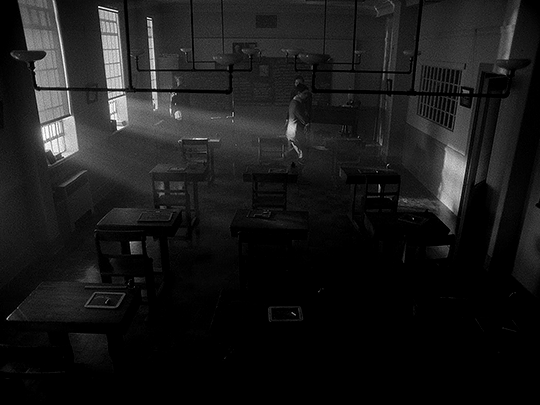
Spherical lenses are often the ‘default’ lens. They’re wonderful and used in a lot of media because they are neutral. They distort less, thus representing the world closer to how it actually is. If we consider the anamorphic lenses in the rest of the show being used to enhance the sense of supernatural and story, changing to a spherical lens enhances the sharp reality. This is Edwin, alive.
The image breaks out of its perceived container, reaching out to the audience, and then changes the lens to be more ‘real.’ In these two changes, not only do we have a more historically accurate image, but it's as if the creators are issuing a warning to us. Maybe the demon isn’t real, but bullies are. Kids can be cruel. Classmates hurt their queer peers. This is not fantasy, and this is as true in 1916 as it is today.
Using a spherical lens in this instance, juxtaposed to the rest of the show, is a dramatic shift to make, as it alters just about everything in the image. In using a less distorted picture, for this, we are reminded of reality and life and the mundane.
On Charles’ Flashback (and an experiment)
Edwin’s flashback got the Cinematography Treatment™ but what about Charles’ flashback? It’s shot with the same aspect ratio and lens as the rest of the show. From the perspective of historical accuracy, this is fine. It’s a scene that could have been shot in 1989, cinematographically speaking. The reason I suspect that it wasn’t given any stand-out look is because, unlike Edwin’s flashback, Charles’ flashback scenes are closely tied to the present-day plot. They aren’t just scenes of Charles remembering things, they are a direct result of the Night Nurse’s “memory magic.”
Maybe changing something here would separate us too much from the plot. Both flashbacks (in episodes 4 and 7) are induced for a specific purpose related to other present-day characters. It wouldn’t make as much sense to have them be standalones.
However, if I were simultaneously the showrunner, screenwriter, and cinematographer, I would give Charles a standalone flashback scene. In that flashback scene, here’s how I would shoot it:
There would be a much deeper depth of field/smaller aperture than the rest of the show, so the background would be more in focus.
There would be harder, less-diffused lighting. This would also impact the coloring, and I’d maybe add some more saturated lights.
I’d try to make an argument to shoot that scene on film (and then argue to do Edwin’s on film too).
There would be a different aspect ratio; 2.2:1 isn’t out of the realm of possibility for the 80s, but it wasn’t common, and it wouldn’t have the kind of impact I’m searching for if it didn’t change.
There are three different aspect ratios I would choose between, and the lens would change depending on my pick.
I’ve made some mock-ups for how these would look, though I cannot adjust things like bokeh and depth of focus, and I can only do so much with the lighting.
2.39:1 with anamorphic lenses (specifically Panavision lenses) This is a super standard widescreen, with a popular lens from the time. We don’t have lens info for the rest of the show, but I think they’re using Panavision anamorphics anyway so the lens may not be a change. Big, blockbuster action movies from the 80s would often be shot in this (perhaps most relevantly, Ghostbusters), and it’s a style that kind of faded in popularity in the 90s and 2000s, so it can have more of a retro look, especially if shot on film. One downside to this would be the aspect ratio change would not be as dramatic.
Movies from the 80s shot with this combo: Raiders of the Lost Ark (and other Indiana Jones movies), Star Wars: Episode V - The Empire Strikes Back (as well as Episode 4, which came out in the 70s. Episode 6 used the same ratio and did use anamorphic lenses, but not Panavision), Ghostbusters
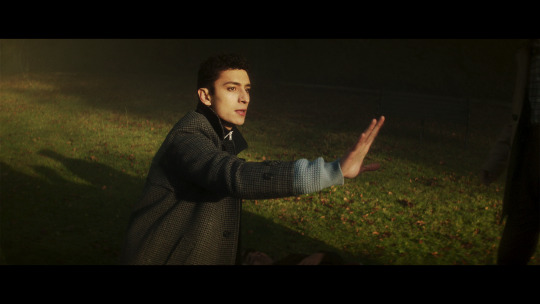
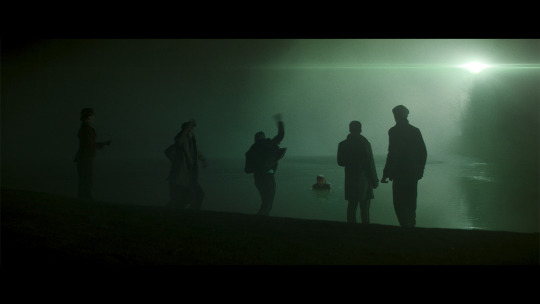
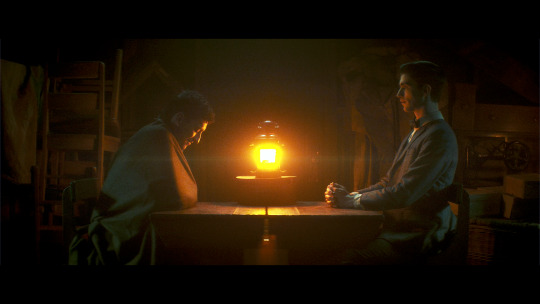
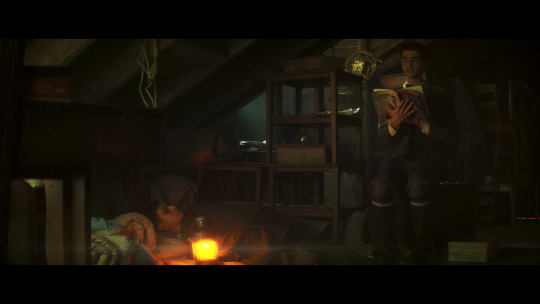
1.85:1 and spherical lenses. This is also ‘widescreen,’ but the advantage of using this aspect ratio is that we could get another dramatic breaking of the image container, just like in Edwin’s flashback. It’s an incredibly common setup, so it’s not really unique, but it would look different from the rest of the show. Given how pervasive ultra-widescreen still is today, I think a lower aspect ratio would also ramp up the ‘nostalgia’ factor a bit. Using a spherical lens we’d end up with the same sense of stark reality that we get for Edwin’s flashback as well (the warning that kids are cruel, but this time to people of color), and I like the idea of that as a parallel.
Movies from the 80s shot with this combo: Back to the Future, Dirty Dancing, The Princess Bride, An American Werewolf in London, Clue, Another Country
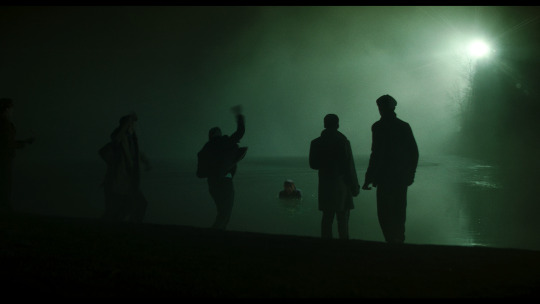
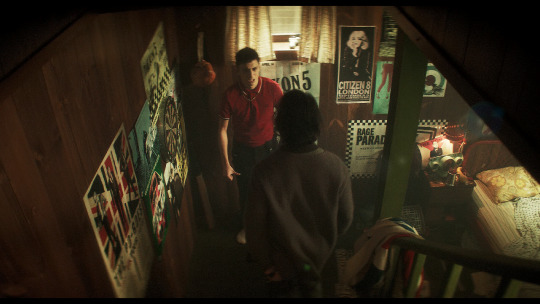
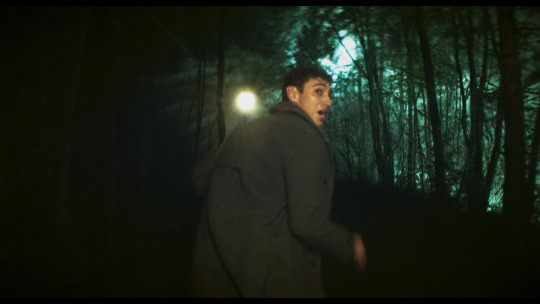
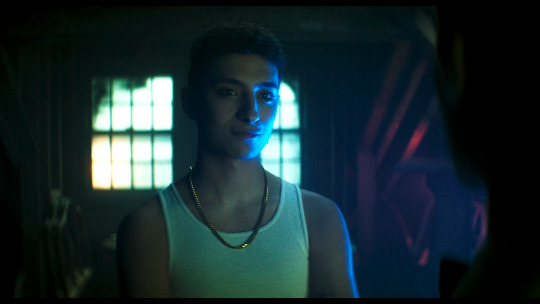
1.66:1 and spherical lenses. This is a ratio that was used widely across Europe, but has never been a common ratio in the USA. However, by the 80s, filmmakers were going for a more widescreen look so it was fading from popularity everywhere. The 80s liked widescreen, so it’s maybe not the best pick for making a scene look “80s”. However, my main motivation for this ratio is that my personal picks for the most Edwin-coded and most Charles-coded queer films are both 80s films shot with a 1.66:1 ratio. We would also get the same benefits from using the spherical lens as I mentioned in the 1.85:1 section.
Movies from the 80s shot with this combo: Maurice, My Beautiful Laundrette, Law of Desire (La ley del deseo), and an honorable mention to Chungking Express, a 90s film that really exemplifies the kind of look I'm going for here

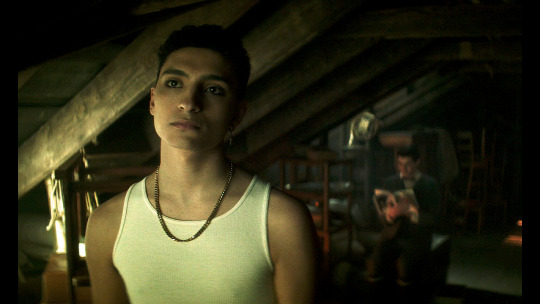
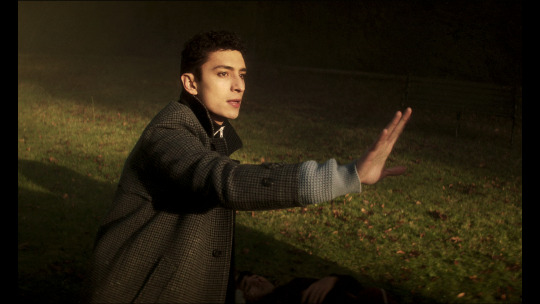
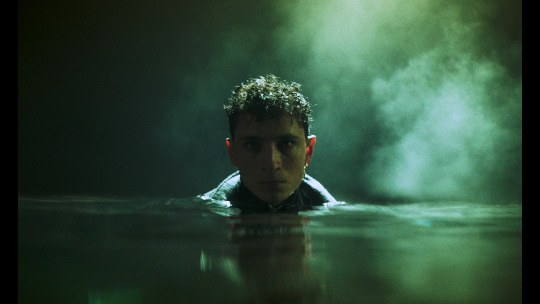
Giving Charles’ flashback a special treatment would probably do a lot to more firmly establish his character as a co-protagonist rather than a deuteragonist, which is definitely not the case but does seem to be how some people view him.
With the impact of the spherical lens and aspect ratio in Edwin’s flashback, the final two options for Charles flashback would be the closest in terms of echoing Edwin’s flashback, and would probably provide the most gravity and sense of crushing reality to the scene.
Setting a single scene (or two scenes) aside like this, with a unique aspect ratio, lens, and color grading (which I didn’t explore much for the Charles flashback), makes us consider a scene more independently from the rest of the show. Edwin’s flashback is a striking moment with a very different look, and that’s deeply memorable. It comes together to push how tragic and unjust Edwin’s story is.
—————
This concludes the planned portion of my cinematography analysis. I had a ton of fun researching and writing this (and making all the graphics) and I hope you all find this interesting/helpful/informative :)
Finally, I want to give another name drop to the cinematographers, Marc Laliberté, Craig Powell, and Pierre Gill. They’ve really nailed it from the very first episode to the last, and there’s so much intention and thought given to every aspect of how they shoot this.
#dead boy detectives#dbda meta#dbda#edwin payne#charles rowland#cinematography#dead boy detectives analysis#cinematography analysis#mygifs#dbdagifs
279 notes
·
View notes
Text

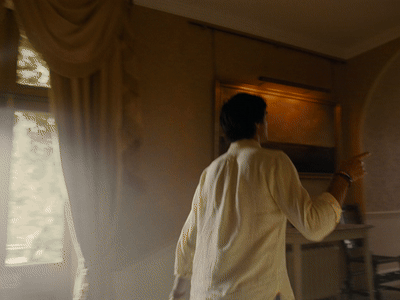

a lot of analysis of "Saltburn" that i see on the internet focus on the text/subtext and maybe the symbolism but i'd like to focus on how messages can be conveyed by the visual elements of the film.
after your first viewing of the film, you've probably asked yourself a lot of questions, including: did Ollie genuinely like Felix (and all his plans derailed dramatically) ? or was Felix a mean to an end from the beginning (and Ollie's mistaken his obsession with Felix, more precisely what he represents (i.e. coolness, wealth, injustice etc) for genuine affection) ?
first and foremost, let's talk about the ratio used all throughout the film which is 1.33:1. so not a perfect square - that would be 1:1 - but here's a screenshot of my computer while i was playing the film on my media player so you can see the biiiig black stripes to the left and right.
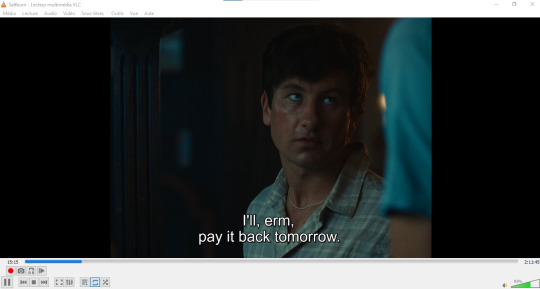
such a square-ish ratio - especially compared to larger ratios, the hollywood standard being 1.85:1 - allows paying attention to the characters instead of the background in wide shots or floor shots and offers 'intimate' close-ups because little to no background is to be see as you get closer to the characters. the main drawback and that we cannot capture imposing backgrounds with it. it just doesn't fit.
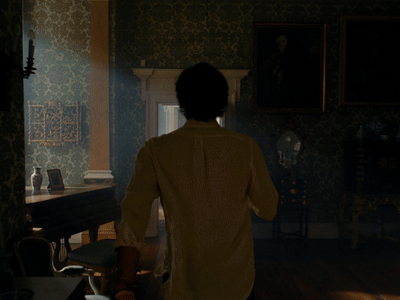


the scene where Felix shows Ollie around the house illustrates perfectly the paradoxes of the film. Saltburn is central to the film and yet just a background.
the camera never moves away from Felix, not even when Ollie looks left and right. to add insult to injury, the narrow frame prevents us from looking at anything else even if we wanted to.

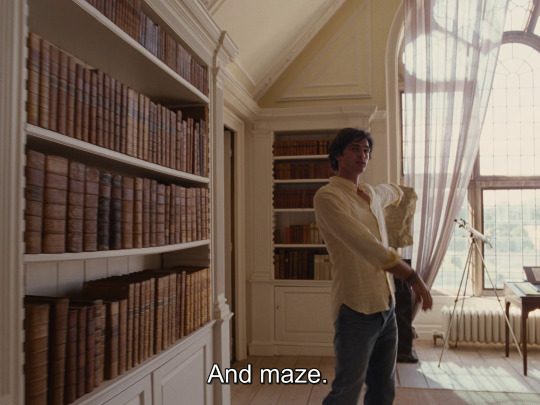
"some fucking hideous Rubens" said Felix. Rubens that...we will never see. same for the maze Felix will die in: we'll see it later.

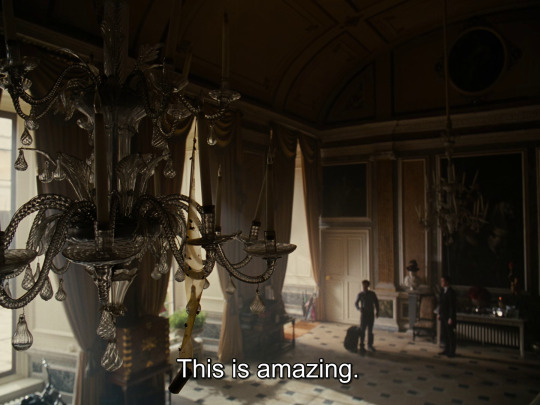
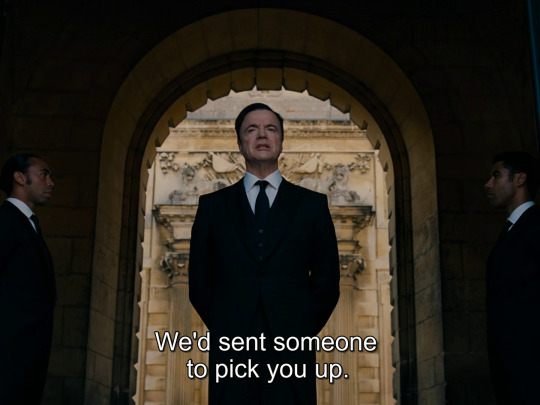

of course, the previous scene depicted Ollie as insignificant compared to the castle but i think this scene is here to establish Duncan as the gatekeeper of the castle in a very literal sense. as if the gates of the castle had taken on a human form in the form of Duncan.
but the moment Felix comes in, all eyes on him.
for me, the message is clear: before the death of Felix, we don't care about the castle . there's not even a single room of that castle that you could describe extensively. do you know what Ollie's and Felix's rooms look like? and the dressing room? etc. Ollie was genuinely obsessed with Felix and he had to improvise when he died that aspect of him is not part of any scheme. in contrary i think the moments when Ollie's sexually excited by Felix (cf bathtub scene, grave scene) are Ollie's rare moments of vulnerability when his real personality slips through. he cold-bloodedly killed all the members of the Catton family except Felix he genuinely cried for.
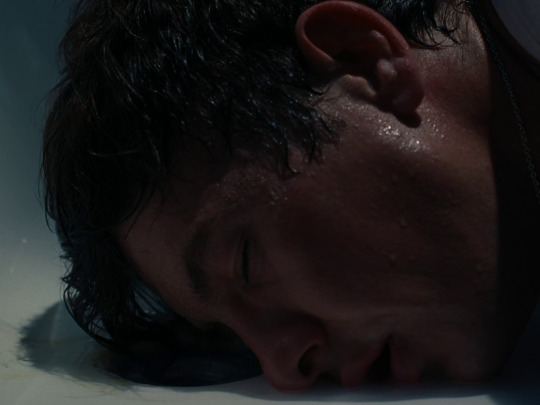
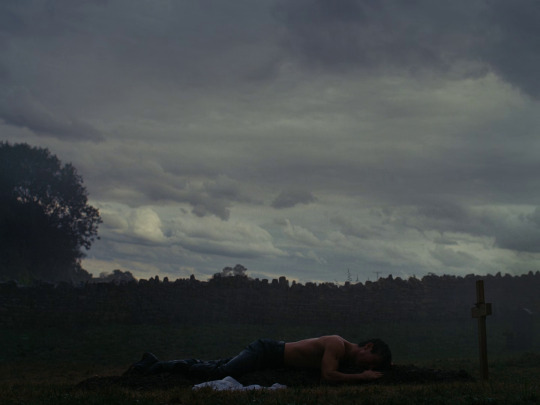
that's why i do not subscribe to the view that every single thing Ollie does is part of a scheme from the get-go. sometimes, Ollie improvises and his obsession for Felix is not a mean to an end.
#saltburn#saltburn spoilers#saltburn movie#oliver quick#felix catton#jacob elordi#barry keoghan#cinemetography
834 notes
·
View notes
Text
Mike Kehoe

Physique: Average Build Height: 6′ 1″ (1.85 m)
Michael Leo Kehoe (born January 17, 1962) is an American politician. A Republican, he serves as the 48th lieutenant governor of Missouri, having been in office since June 18, 2018. Kehoe previously served in the Missouri Senate, representing the state's 6th senatorial district, and served as Majority Leader from 2015 to 2018. On June 18, 2018, Governor Mike Parson appointed Kehoe as Missouri's lieutenant governor. Both Parson and Kehoe were elected to a full term in 2020.





Ruggedly handsome, Kehoe reminds me of President Lyndon Johnson as he too carries that big dick energy.


Kehoe was born and raised in the St. Louis area by his single-parent mother. The youngest of six children, his father left the family when he was only one year old. At age 15, Mike started working at a dealership to , eventually becoming the New Truck Sales Manager at the age of 23. A couple of years later, he ended up buying a struggling company, Osage Industries, a van conversion and ambulance manufacturing company in Linn, Missouri. Over a five-year period, the company doubled in size and is now one of the largest ambulance manufacturers in the world.



After selling Osage Industries in 1992, he purchased an auto dealership in Jefferson City, Missouri, but sold it shortly after entering politics.




Mike and his wife, Claudia, are proud parents of four children. Lets see what else I can find out about him. Mike is a champion cutting horse rider and a successful cattle farmer on a 700 acre farm in Phelps and Pulaski Counties. Nice to know he's a champion in riding as that could translate to the bedroom.

111 notes
·
View notes
Text
Well duh, they're not going to eat Tubby Custard while they're asleep...
THEY MADE THE FUCKING TELETUBBIES WOKE
#the teletubbies#I've not seen the new show#all I know is the aspect ratio has changed on their gut monitors to 1.85:1
32 notes
·
View notes
Text
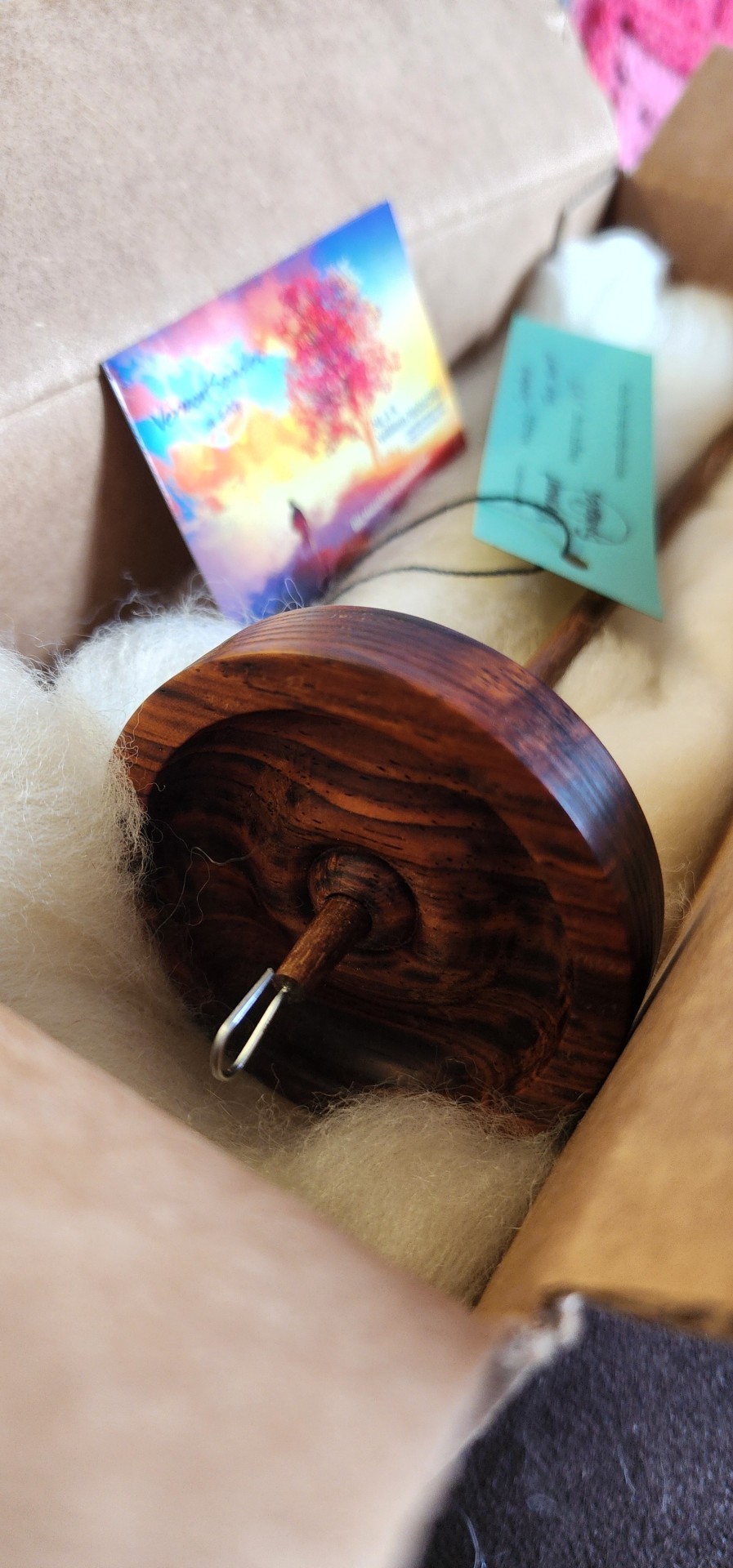
Guys, meet Coco ♡
So named for the protaganist from Witch Hat Atelier because a spindle is the closest I'll come to a real magic wand pen.
I can't wait to spin many magical things together ^_^
#I have already been experimenting with different blends I set aside#I'm so excited!#hand spinning#craftblr#yarn#wool#fibre#drop spindle#Coco#Vermont Spindles
79 notes
·
View notes
Text


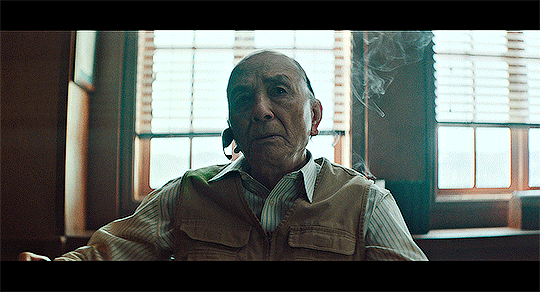

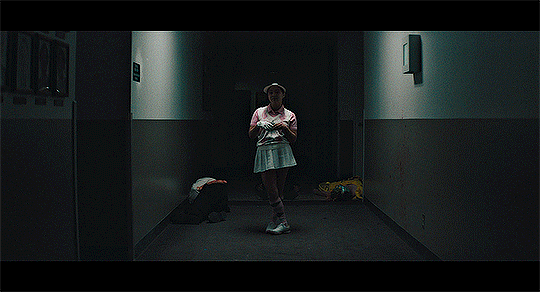




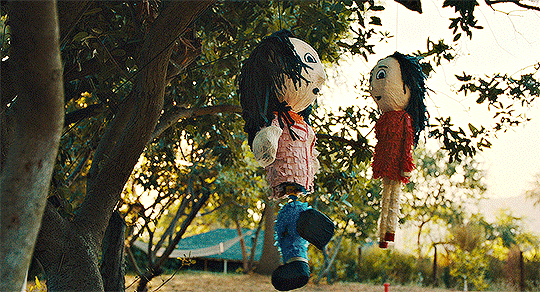
The Cinematography for the Academy Award for Best Picture:
Film: Everything Everywhere All at Once
Year: 2022
Director: The Daniels
Cinematographer: Larkin Seiple
Aspect Ratio: 1.85:1; 1.33:1 (some scenes); 2.00:1 (some scenes); 2.39:1 (some scenes)
#everything everywhere all at once#eeaaoedit#eeaao#filmedit#dailyflicks#zombooyah#oscarsedit#oscars#bpc#my gifs#cinematography#cinematographyedit
311 notes
·
View notes
Text

















**Shots of the Episode**
The Bear (2022)
Season 3, Episode 1: “Tomorrow” (2024) Director: Christopher Storer Cinematographer: Andrew Wehde
#shots of the episode#fx#the bear#the bear season 3#the bear spoilers#hulu#fx on hulu#the bear hulu#the bear tomorrow#tomorrow#christopher storer#andrew wehde#jeremy allen white#lionel boyce#ayo edebiri#ebon moss bachrach#cinematography#molly gordon#carmy berzatto#carmy x claire#stills#screencaps#sydney adamu#richie jerimovich#2024#2024 tv#tv#streaming#screenshots#1.85:1
95 notes
·
View notes
Text
Also preserved on our archive
by Kristen Monaco
Risk of new diabetes diagnosis was higher compared with non-COVID respiratory infections
Children and teens had an increased risk of being diagnosed with type 2 diabetes after COVID-19 infection, a retrospective cohort study of over 600,000 youth suggested.
Adolescents 10 to 19 years old had a 55% higher risk for a new diagnosis of type 2 diabetes 1 month after a COVID diagnosis compared with peers diagnosed with a non-COVID respiratory bug (risk ratio [RR] 1.55, 95% CI 1.28-1.89), reported Pauline Terebuh, MD, MPH, of Case Western Reserve University in Cleveland, Ohio, and colleagues.
The risk of a new type 2 diabetes diagnosis remained elevated at 3 months (RR 1.48, 95% CI 1.24-1.76) and 6 months (RR 1.58, 95% CI 1.35-1.85) after COVID infection, the group detailed in JAMA Network Openopens in a new tab or window.
"Youth diagnosed with diabetes will carry the burden of diabetes-related complications and increased medical costs for many years," Terebuh told MedPage Today. "All potential contributors to that trend are deserving of our attention, including COVID-19 and the increasing prevalence of obesity."
"COVID-19 is becoming endemic and strategies for mitigating its impact are extremely important," she said.
"SARS-CoV-2 may have the ability to selectively infect human pancreatic β cells, and if this triggers apoptosis, the ability of the pancreas to secrete insulin may be impaired," the researchers suggested. "Though T2D [type 2 diabetes] is usually considered to be a disease of insulin resistance rather than insulin lack, for newly diagnosed patients, the origin may not be entirely clear or confined to a single pathobiologic cause."
This wasn't the first time research suggested a link between COVID infection and diabetes in youth, but up until this point, most research focused on the relationship with type 1 diabetes. However, these studies have shown mixed results, with some studies indicating a linkopens in a new tab or window, and others dismissing the associationopens in a new tab or window.
Terebuh said while data have indicated an overall increase in new diagnosesopens in a new tab or window of type 2 diabetes among youth during the first year of the pandemic, this uptick has been a "worrisome trend" for decades.
"However, lots of things changed for youth during the pandemic from access to food to level of activity and stress," she pointed out. "The association with a COVID-19 diagnosis, per se, was not clear." To delve further into the topic, the researchers reviewed electronic health records on 613,602 patients from the TriNetX analytics platforms between January 2020 and December 2022. This included 306,801 patients diagnosed with COVID-19 (mean age 14.9 years, 52.8% female) and 306,801 with other respiratory infections (mean age 14.9 years, 52.6% female), after propensity score-matching.
Preexisting diabetes was grounds for exclusion.
In a subpopulation of adolescents with a BMI designating overweight or obesity (BMI in the 85th percentile for age or higher), a COVID diagnosis was tied with higher risks for developing type 2 diabetes at all three follow-up points compared with other respiratory infections: 1 month after: RR 2.07 (95% CI 1.12-3.83) 3 months after: RR 2.00 (95% CI 1.15-3.47) 6 months after: RR 2.27 (95% CI 1.38-3.75)
"New drugs for diabetes and obesity, such as GLP-1 receptor antagonists, provided they are safe, may have a role that should be studied," Terebuh suggested. Additionally, the researchers found the risk for developing type 2 diabetes was the highest for adolescents who were hospitalized within 1 month of a documented COVID infection: 1 month: RR 3.10 (95% CI 2.04-4.71) 3 months: RR 2.74 (95% CI 1.90-3.96) 6 months: RR 2.62 (95% CI 1.87-3.66)
Some diabetes diagnoses may have been preexisting and were discovered during the encounter for infection, the researchers pointed out. "Diagnoses made in the first month following infection may well represent preexisting disease, since the diagnosis of T2D is often confirmed by HbA1c measurements, which use mean blood glucose levels over the life span of the erythrocyte, or over 3 to 4 months," they wrote.
It will be important to test whether patients diagnosed soon after COVID-19 infection continue to meet diagnostic criteria for type 2 diabetes to separate patients who had diabetes from those who became hyperglycemic only during the metabolic stress of infection, they added.
Other limitations included potential confounders like vaccination status, socioeconomic status, BMI, or insulin resistance. In addition, patients with obesity and overweight weren't matched for obesity-specific treatments.
Study Link: jamanetwork.com/journals/jamanetworkopen/fullarticle/2824731
#mask up#covid#pandemic#wear a mask#public health#wear a respirator#covid 19#still coviding#coronavirus#sars cov 2#long covid#diabetes
18 notes
·
View notes
Text
Zine update
I have had many orders! A lot more than I was expecting. Enough that I had to order more card and more compostable plastic sleeves, and this evening I will be stitch-binding the 30 new copies of the zine I printed and folded today, and I'm a little bit nervous that by the time I am finished there will be more orders than zines again...
Which is, GREAT obviously, I am really happy about it! And I don't think anyone will be waiting longer than is reasonable for their copy to arrive. But at the same time I am a little bit nervous, because I can be a bit unreliable due to the various disabilities and sometimes I get unpredictably in pain/exhausted.
So, if I'm very quiet, don't worry, I'm just assembling and posting out some zines, and possibly napping. And if anything goes wrong or there will be more of a wait than anticipated, I will post and let you know.

Here's the post about the zines again. They're £4 each (plus P&P), like so:
UK 1st class, £6.35 - £4 for one copy, plus UK first class postage £2.35 (1-2 days)
UK 2nd class, £5.85 - £4 for one copy, plus UK first class postage £1.85 (2-4 days)
Outside UK, £7.20 - £4 for one copy, plus postage to anywhere outside of the UK £3.20 (5-7 working days)
Update 2024-06-20: They're now available through our new online shop!
[ The annual 2024 Gender Census survey is open NOW until 13th June ]
25 notes
·
View notes
Note
Hey Mike, can you talk about your work on Revival? What was it like reading the book, writing the script, making it all work? I know people thought it was going to be like Midnight Mass, but King is tackling religion far differently & I would have loved to see your adaptation of that. Furthermore, why did you decide to leave the project? I read somewhere it had to do with the film rights, but I’m sure there’s more to that story & id love to hear your side of it.
Also, Life of Chuck…. 1.85:1 or Scope? C’mon, Mike! Spill the beans!
Thanks!
I was very excited about Revival. King had given me the rights after I finished the script for Doctor Sleep, and we took it around town as a pitch. Warner Bros. picked up the project and commissioned the script.
I wrote a script I love, and turned it in to Warner Bros. It couldn't be more different than Midnight Mass; that was always a very weird and unfair comparison. The only thing they have in common is that each story features a priest; any comparisons wouldn't have survived opening weekend, that was never really a thing.
Revival is one of King's scariest and most effective books, and I was madly in love with the movie. I stayed very true to the book, and the story spanned over decades. It was a character-forward epic about mortality, and the futility of hope, dealing with themes of lost love, addiction, and hubris. In fact, it has way more in common with Frankenstein than Midnight Mass, and I was stoked to make it. It wasn't cheap, though - the set pieces were big, the VFX budget was intimidating, and it fit into a type of budget that isn't typically made these days.
For those reasons, ultimately, after Doctor Sleep's disappointing performance at the box office, Warner Bros. didn't want to pursue the movie. They had really liked the Frankenstein comparisons, but that only comes into play at the very end of the story. Their pitch was to start the story there, and jettison most of the actual novel in favor of a new, heavily Frankenstein inspired narrative. It was a bridge too far, and changed the source material too radically.
Warner Bros. faith in the project had been seriously damaged by the box office performance of Doctor Sleep, and the character-forward epic I was pitching was just too risky given the hefty price tag. Ultimately, I wasn't willing to change the story as drastically as they wanted to, and it just didn't make sense to make it for that budget - so they opted not to make the film, and that was that. I didn't leave the project at all - the studio just didn't want to move forward with it. Revival is not the most obvious project. It is more expensive than a lot of comparable horror titles, and we didn't want to do it as a streaming movie - we bet the farm on a theatrical feature, and the cards didn't fall in our favor this time. My window of availability as a director rapidly closed. I was heading fast into Midnight Club and Fall of the House of Usher for Netflix, so without a viable attachment from me for at least a few years, the project couldn't move forward at all, and the rights reverted back to Stephen King. We discussed whether we wanted to try to keep it alive, but we were already deep into talks about The Dark Tower, whose rights were about to become available after years of being tied up. Steve doesn't like to give the same person multiple rights as a general rule, because he doesn't want his projects to stall out in development, which makes good sense. Given the choice, we absolutely wanted to focus on The Dark Tower. We let Revival go, and last I heard, some other people were developing it as a TV project. I absolutely love the script I wrote, and I'm disappointed that Warner Bros. didn't want to make it, but it's their studio and their prerogative. I can't say I blame their reasoning. In fact, I completely see their point. I could have dug in and fought harder to keep it, but that might mean I wouldn't have gotten the rights to The Dark Tower.
And I hate to say it, but Revival would have taken a similar narrative approach to Doctor Sleep, and - well - audiences just didn't show up for that movie. It's entirely likely that the same would have happened here - this was another long, character-centric story that wasn't entirely a mainstream horror tale, and it was expensive. And this didn't have The Shining connection to lean on. I am so sorry to say this, but I don't have a lot of faith that audiences would have supported us if we'd bet the farm on a theatrical release of Revival as I wanted to make it. So honestly, I think it all worked out for the best. You win some and you lose some in this business. Who knows, maybe it'll come back some day - I also lost the rights to Gerald's Game back in 2014 when we couldn't find a partner who wanted to make the movie. They eventually came around again, and the timing worked out. The same could happen here - maybe we get another chance, or may we revisit it down the line as a limited series. Stranger things have happened. Ka is a wheel. Or, maybe this new television production of Revival will get off the ground, and if it does I wish them nothing but the best with it. It's a phenomenal story, and I'll be first in line to see it.
151 notes
·
View notes
Text

The Warriors will be released on 4K Ultra HD and Blu-ray on December 12 via Arrow Video. Laurie Greasley designed the new cover art for the 1979 action thriller; the original poster is on the reverse side.
Walter Hill (48 Hrs., Deadwood) directs from a script he co-wrote with David Shaber (Nighthawks), based on Sol Yurick's 1965 novel. Michael Beck, James Remar, Deborah Van Valkenburgh, Marcelino Sánchez, and David Harris lead the ensemble cast.
The limited edition set comes with a 100-page book featuring new writing by film critic Dennis Cozzalio plus archival material, a double-sided poster, six art carts, and gang logo stickers.
Both the theatrical cut and the 2005 alternate version have been newly restored in 4K from the original camera negative, approved by Hill, with Dolby Vision. The theatrical cut is presented in its original 1.85:1 with original uncompressed mono, stereo 2.0, and Dolby Atmos audio. The alternate cut has stereo 2.0 and DTS-HD MA 5.1 audio.
Special features for the two-disc set are listed below, where you can also see more of the packaging and contents.

Disc 1 - Theatrical Cut:
Audio commentary by A Walter Hill Film author Walter Chaw (new)
Isolated score option
Interview with director Walter Hill (new)
Roundtable discussion on The Warriors with filmmakers Josh Olson (A History of Violence), Lexi Alexander (Green Street), and Robert D. Krzykowski (The Man Who Killed Hitler and then Bigfoot) (new)
Interview with editor Billy Weber (new)
Interview with costume designer Bobbie Mannix (new)
Costume designs and photographs from the archive of designer Bobbie Mannix (new)
Sound of the Streets - An appreciation on Barry De Vorzon's The Warriors score by film historian Neil Brand (new)
Filming location tour (new)
The Beginning - Making-of featurette with director Walter Hill, producer Lawrence Gordon, actor James Remar, and editor David Holden
Battleground - Featurette on shooting in New York City with director Walter Hill and assistant director David O. Sosna
The Way Home - Featurette on the look of the film with director of photography Andrew Laszlo
The Phenomenon - Featurette on the film's legacy with director Walter Hill and cast members
Theatrical trailer
Image gallery
Disc 2 - Alternate Version:
Introduction by director Walter Hill
Also included:
100-page book with new writing by film critic Dennis Cozzalio plus archival material
Double-sided fold-out poster with original and new art
6 postcard-sized art cards
Gang logo stickers
In New York the gangs outnumber the cops by 5-1. Together, they could rule the city. Gang-leader Cyrus has a dream to do just that and calls a summit. The gangs of New York gather in their thousands, Cyrus takes the stage. From somewhere in the crowd a shot rings out and Cyrus falls down dead. In the chaos that follows, a small gang from Coney Island – the Warriors – are blamed. Now everyone is out to get them. On foot, in enemy territory, can they make it through the night to get back across the city to the safety of home turf?
Pre-order The Warriors.
#the warriors#walter hill#james remar#michael beck#david harris#70s movies#1970s movies#exploitation#arrow video#dvd#gift#laurie greasley#sol yurick
66 notes
·
View notes
Text
My experience and things that happened at the Voltaire concert :]
First of all, a lot of strange things happened jajaja
It was literally the first time I went to a convention and a concert, so my hands were shaking a lot; Even when I went to buy the tickets for the photo and the autograph, the ladies who were collecting told me "Cálmate jaja, ni que se te fuera a ir (calm down jaja, he's not going to leave)".
Well, I approached where he was giving autographs and cell phone photos (my dad vanished, he went to buy prickly pears)
Voltaire and Mayumi greeted me very kindly greeted and I asked him (almost crying) to sign my drawing of "Riding a Black Unicorn", I thought he was just going to sign it and that's it. but when I gave him the drawing, he saw it and asked me "Tu dibujaste esto? (Did you draw this?)" but, he asked me surprised, I answered yes, He told me that I drew very well and he showed it to Mayumi and she also told me that I drew very well (I was almost dying of happiness, I just didn't cry because I had eyeliner and I didn't want it to be ruined) he signed my drawing and asked if I could take a photo with them, they told me yes and my father took the photo with me jskakjsa with. and then he asked me "como te llamas? (what's your name?)", I told him my name, and he told me "Maren? dibujas muy bien, espero que sigas dibujando (You draw very well, I hope you continue drawing)" and shake my hand (I almost cried ×2)
And something strange happened when he was going to sit down kajsjsja, As I said, my father was going to buy some prickly pears, Well, I'm going to try to explain this in the best way possible, because it is better understood in Spanish.
My father was eating prickly pears and Voltaire approached him and asked him what he was eating (yes, super random) and my father said "Tunas"
Prickly pears, in Spanish they say "tunas", and "atún" in English is tuna, I hope it is understood, Basically Voltaire thought my father was talking about tuna, when in reality he was talking about prickly pears
And Voltaire answered "Tunas?", my father said yes and Voltaire asked again "Tuna de Atún?" and my father replied "No, no, tuna de, de tuna" (wtf?) (he forgot how to say "tuna" in English) ". . . De atún?" "No, no, de, de cactus!" "Aaaaaah" kakjsjaajaa and then he said to Mayumi "Mayumi!, hay tunas! (there are prickly pears!)"
Afterwards, I think he went to buy prickly pears, and I bought the key (500 pesos, holy shit, I spent half of my savings, but it was worth it) I also remember that I told Mayumi (because she was the one who sold me the key) "I'm sorry, I'm very nervous" and Mayumi replied "Aaaaw, don't worry"
But then, I remembered that I spent some time thinking about what would happen if I asked him for a hug, and that's what I did, I asked him "oiga, le puedo dar un abrazo, porfavor (hey, I can give you a hug? please)" (Call me strange, but I literally got to the concert with tears, sweat and blood, I needed that hug) and he didn't say anything to me, he just extended his arms and I gave him a hug.
Then, about 10 minutes before the concert started, He was no longer where he was giving autographs, and me and my father went for Chinese food, well, my father, because I was just thirsty even though I had only eaten one sandwich all day (Monterrey is a fucking oven) While we were in line to buy food, my father called me and I turned to find out what he wanted. . . Voltaire was behind me, no joke, seriously, And then, I took the opportunity to ask him what his height is, He told me that he wouldn't know how to say it, because he uses the system of inches, feet, yeah jaja, In the end he told me 6'1 (1.85 meters) Then Mayumi came and Voltaire asked her "Amor, cual es mi altura?" and Mayumi answered that 1.85 meters, It was irrelevant to say this, but I only wanted to because I found him in the fucking line to buy Chinese food, I mean, that only happend in La Rosa de Guadalupe.
now, the concert yippee
1.- At the beginning (finishing the song from The Last Halloween party) the microphone started to fall and he started shouting "Diurex!, Diurex!" And then he asked whoever was there "Amigo, tienes Diurex o algo? (Dude, do you have Diurex or something?)"
2.- Finishing the song "The Skeleton Dance" he said "No me lo vas a creer!, no me lo vas a creer!. . . Pero yo era ñoño. . . Talvez si me creas porque sigo siendo ñoño, pero ahora soy ñoño vampiro" (I, you're not going to believe me! You're not going to believe me... But I was a nerd... Maybe if you believe me because I'm still a nerd, but now I'm a nerd vampire)" akkskajs and began to tell about his life
3.- After telling his past he said "I ahora teniando 57 años, yeah, that's right, fifty seven, es una de las momias de Guanajuato, wey! (And now being 57 years old. Yeah, That's right, fifty seven, it's incredible, dude!, is one of the mummies from Guanajuato" At that age he still liked the same things as when he was 17
4.- I don't remember very well, because I didn't record it, that he said that people on the street told him "Que buen disfraz de dracula! (what a great Dracula costume!)" "Hey, todavia no es Halloween! (Hey it's not Halloween yet!)" and that offended him a lot, but after a while he no longer saw it as something bad and said "Ahora cuando la gente en la calle me dice 'que buen disfraz de dracula', yo les contesto 'Ay, muchas gracias! (Now when people on the street tell me 'what a great Dracula costume' I answer 'Oh! Thank you very much!')", but, he said it with a tone of voice and a pose that, jaja, made me laugh a lot
5.- I was saying that her most popular song is "The Night" because, well, it is the number one episode of "The vampair series" Well, he said that that song was very difficult and that he called his producer and told him to hire a professional guitarist, then they paid him his 3.5 kakskaks pesos ( joke, that lasts the song) and his producer told him something like "No hagas eso, porque cuando vayas a un concierto no vas a saber tocar esa cancion en vivo (don't do that, when you go to a concert, you won't know how to play that song)" and Voltaire said "Yo nunca voy a tocar esa canción en vivo! A nadie le va a importar esta canción!. . . 20 años después (I'm never going to play this song live! Nobody is going to care about this song! . . 20 years later)"
6.- After saying that he said "se vuelve viral, tiene 54 millones de views, y ahora yo, yo me tengo que, is embarrassment, I have to embarrass myself, me tengo que embarazar (it goes viral, it has 54 million views, and now I, I have to. . . is embarrassment, I have to embarrass myself, I have to get pregnant" okay, Let me explain, because this is a joke in Spanish, "embarrass" In Spanish, it means "avergonzar", buuuut, sounds VERY SIMILAR to "embarazar" and it means "to get pregnant" I hope it was understood jaja
So, he got confused, I don't know if it was a joke or not but he said "No me voy a embarazar? (Aren't I going to get pregnant?)"
7.- After finishing "The Night" said "Muchas gracias, ahora si necesito una chela (Thank you very much, now I need a beer)"
8.- Now "Raised by bats" because it gave an introduction of how he went to New York and ended up in places like that, he even made a joke that "termine en lugares, masomenos similares a este, termine con gente *señala al publico* se parecian masomenos a ustedes (I ended up in places. . . Let's say something like this, and I end up with people *points to the audience* more or less similar to you)" and he said to a guy "te digo, me encata tu disfraz, pero creo que no es un disfraz, asi es, asi es y asi es como debe ser (I tell you, I love your costume, but, I think it's not a costume, that's how it is, that's how it is and that's how it is It must be)" Then he said "En otras palabras, en otras palabras, yo encontre mi tribu (In other words, in other words, I found my people)"
9.- Then he said about "Raised by bats" he said "Aqui todos somos. . . Raritos (Here, we are all of us. . . Weirdos" but he said that in the USA he calls them "lovable weirdos" and he asked what that would be like in Spanish and they told him and he said "Raritos encantadores"
10.- He gave an introduction to his program "Gothic Homeking" and then said "Yo me despierto todas las mañanas, a las 4 de la tarde, y trato con toda mi alma y mi esfuerzo, vestirme como un villano de Disney. . . Y si esa gente afuera, piensan que porque así decoro mi casa y así me visto, eso me hace 'malvado' porque así me llaman, malvado, pues. . . Quizás así es (I wake up every morning, at 4 in the afternoon, and try with all my soul and effort to dress like a Disney villain. . . And if those people outside think that because that's how I decorate my house and that's how I dress, that makes me 'evil' because that's what they call me, evil, well. . . Maybe that's how it is)" holy shit, wow, even in the video you can see that I scream like a crazy bitch because he was already going to sing "When You're Evil"
11.- The Beelzebub's Philharmonic Choir, which is when people from the audience went up with Voltaire to sing, and I said "DAD, RECORD, RECORD" He said "déjame ver tus manos, si has, si has, ugt, en español! Déjame ver tus manos si has, si me has visto en concierto, otra ves. . . Sube las manos si esta es la primera vez que me vez en un concierto (entro yo kakska) pues, si has visto uno de mis conciertos, sabes que esta es la parte del show, donde yo escojo gente del público- (let me see your hands, if you have, if you have, ugt, in Spanish! Let me see your hands if you have, if you have seen me in concert, again. . . Raise your hands if this is the first time you see me at a concert (I enter kakska) well, if you have seen one of my concerts, you know that this is the part of the show, where I choose people from the audience-)" I don't remember anymore He said why I stopped recording to go to the stage, but he said that the only requirement was that we knew "When You're Evil" in full, I didn't know it but it was worth it to me and I looked for the lyrics in google
12.- when we sang the part that said
I pledge my allegiance, to all things dark
And I promise on my damned soul
To do as I'm told, Lord. Beelzebub
You have never seen a soldier quite like me
Not only does his job, but does it happily
He said "Aplausos, Aplausos, es lo menos que podemos hacer, terminan de vender sus almas a satanas en el encenario (applause! applause!" "It's the least we can do, you end up selling your soul to Satan on stage)"
Jajajakaka
Then I went to the professional photo and took a photo with him and I said something like "Hey, I would like to give you my pins that I have from you" and he stared at my pins and asked me if I I did, I told him no, that I had just done the almost human one and he told me (again) that it was very nice. Afterwards he told me that I could only take one, but that I should choose the one I liked the least, but he told me with a kindness and a smile that, God, displayed an aura of security. In the end, I gave him the one for "The Black Labyrinth" and the one for "Riding a Black Unicorn"
Well, he wore the one from Black Labyrinth (I saw it as logical because it came in black) but I thought he would only wear it while I was looking at him. The pin was never removed again, after I gave him the pin, he didn't take it off again.
"It doesn't matter, that's what I work for" but he didn't accept, I asked him for one last photo with the pin and I remembered that I had a drawing of Feathery wings, I showed him the drawing and asked him if he could sign it, but if he didn't want to anymore, that was fine, because I had already spent the autograph ticket and he asked me "Porque pensaste que no te lo iba a firmar? (Why did you think I wasn't going to sign it for you?)" And he stared at the drawing while I explained it and he asked me again, if I drawn that, just as surprised as before, and I think he was convincing me to give it to him and I told him it was for a friend and in the end He understood and signed it, I asked him if he was going to come next year and he said yes they invited him and. . . Ready, I'm gone, from the best moment of my existence so far.
#aurelio voltaire#oh my goth!#lmao#almost human#raised by bats#send help#fanart#lo logre#i did it#la conve#animex#monterrey#concert#he was very kind#*cries*#the halloween forever tour#the last halloween party#the devils bris
16 notes
·
View notes